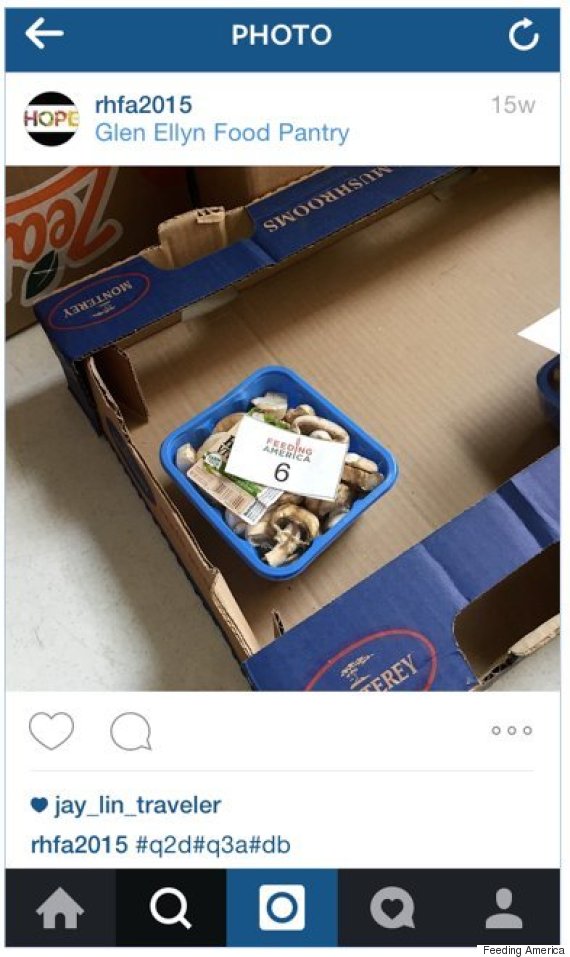Each year, more than 46 million people in need of food assistance turn to the Feeding America network of food banks for relief. We know a lot about the people we serve -- in fact, more than 60,000 individuals were interviewed in the summer of 2013 to share their circumstances as a part of Hunger in America 2014, the largest study of domestic hunger carried out by Feeding America every four years since 1993.
Although this survey provides immensely valuable information about demographics, it doesn't begin to scratch the surface of asking the people we serve for their feedback and satisfaction with the foods received. It also doesn't provide us with any visual insight into their experiences at food pantries.
Understanding people's preferences with the food they receive is helpful because at Feeding America, we want to be sure we are distributing food that people can eat, and not food they avoid due to dietary, health, religious or cultural reasons, for example. We want to be sure we are not wasting resources by distributing food that goes uneaten.
Social Media Research Pilot and Proposal
Recognizing this opportunity, Feeding America teamed up with the American Association for Public Opinion Research (AAPOR) at its 2014 annual conference to explore novel ways to leverage technology to innovate survey research. Entitled ResearchHack, the inaugural two-day seminar tasked young AAPOR members with designing a research study that would benefit the Feeding America network using a common social media app: Instagram.
Working collaboratively, Research Hackers presented several innovative proposals that leveraged Instagram's hashtag and geolocation features that caught the attention of the Feeding America research team. Feeding America asked the Hackers to come aboard, and several months later, the two joined forces to develop a pilot study using Instagram with volunteer data collectors at real pantries. The team seized the opportunity to get visual insight into food preferences, and surveyed more than 60 food pantry recipients across two states by asking a set of questions that determined if there were foods they were unable to eat.

Using Hashtags as Survey Response Answers
Equipped with the mission, the team went into the field and trained food pantry volunteers how to use the Instagram app to collect the responses of food pantry recipients. Using a "show card" with the survey questions and answer options written out, respondents selected their answer which was converted to a hashtag.
Question #1 asked: "Out of all the food you received (or being offered) today, is there a food item you will not use or cannot eat?" To respond to this question, data collectors took a photo of the food item. Question #2 posed: "Why not?" and offered the following reasons:
a. Food allergy or intolerance
b. Dietary restriction
c. Religious dietary practice
d. Not familiar with, don't know how to cook or don't have equipment
e. Don't like or children don't like
f. Nothing (will use everything)
g. Not healthy
h. Other
For example, if a recipient answered that they did not take peanut butter because they are allergic to peanuts, the volunteer uploaded a photo of the peanut butter with the hashtag #q2a to illustrate it was answering the second question using the first answer option (a).
Future Possibilities
Although this pilot was Feeding America's first foray into using social media as a survey research tool, there is great possibility for leveraging the platform in other research endeavors, including possibly empowering the people we serve to use the app to upload photos and remarks themselves. As the intersections between the technology and social impact worlds continue to align, there remains great opportunity to leverage these novel tools for the greater good. I'm confident that in the future, social media will prove an invaluable tool in helping us meet the needs of the people we serve and make a big impact in the fight to end hunger.
Learn more about Feeding America's research, how we are fighting hunger and how you can help. To learn more about hunger in your community, find and contact your local food bank.
Special thanks to the Northern Illinois Food Bank in Geneva, Ill. and Food Gatherers food bank in Ann Arbor, Mich. for allowing the ResearchHack to take place at their local agency partners.
Special thanks also to SSRS for providing technology for use during the pilot phase.
Also, we sincerely appreciate the people we serve at food pantries who participated in this pilot by providing us with their feedback.
Feeding America is a partner of Cisco CSR. Cisco sponsors The Huffington Post's ImpactX section.